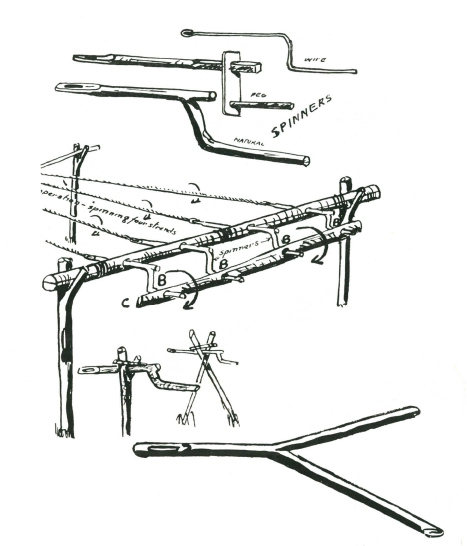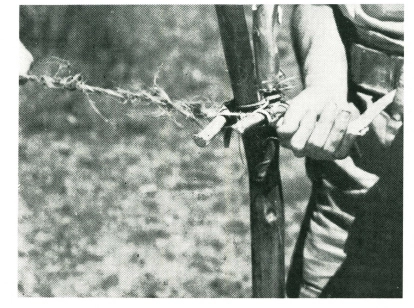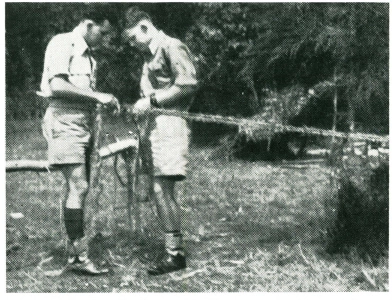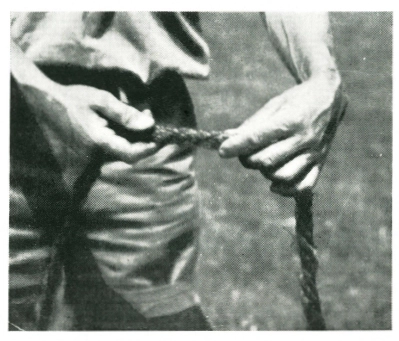The cross bars must be smooth, and free from twigs and loose portions of bark that might twist in with the spinning strands.

The cross bar A is supported by two uprights, and pierced to take the cranks B. These cranks can be made out of natural sticks, morticed slab, and pegs, or if available, bent wire. The connecting rod C enables one man to turn all cranks clockwise simultaneously. Crossbars supporting the strands as they are spun are shown D. A similar crank handle to C is supported on a fork stick at the end of the rope walk. This handle is turned in reverse (anti-clockwise) to the cranks C to twist the connected strands together. These are ‘laid up’ by one or more of the feeders.
Always make it a rule to turn the first strand clockwise, then the laying up of the strands will be done anti-clockwise and the next laying will again be clockwise.

Bark fibre being spun into strands using a single crank handle.

Spinner-feeder on right with bundle of material under his right arm feeds in material.

Joining the strands prior to lay up.

Testing the rope of bark fibre, breaking strain 1” diameter, about 800 lbs.

Close up of the finished rope.
Proof that your rope is well made will be if the individual fibres lie lengthways along the rope.
In the process of laying up the strands, the actual twisting together, or laying will take some of the original ‘twist’ out of the strand which has not yet been laid. Therefore it is necessary to keep twisting the strands whilst laying together.
When making a rope, too long to be spun and laid in one piece, a section is laid up, and coiled on the ground at the end of the rope walk farthest from the cranks. Strands for a second length are spun, and these strands are married or spliced into the strands of the first section and then the laying up of the second section continues the rope.
The actual ‘marrying’ of the strands is done only in the last lay, which when completed makes the rope. The ends where the strands are married should be staggered in different places. By this means rope can be made and extended in sections to a great length.
After your complete length of rope is laid up, pass it through fire, to burn off the loose ends and fibres. This will make your rope smooth and most, professional looking.
LAYING THE STRANDS
The strands lie on these crossbars as they are spun. When the strands have been spun to the required length, which should be no more than about a hundred feet, they are joined together by being held at the far end. They are then ready for laying together.
The turner, who is facing the cranks, twists the ends together anti-clockwise, at the same time keeping his full weight on the rope and which is being layed up. The layer advances placing the strands side by side as they turn.
Laying up is very fast when the layer is experienced. He quickly gets the feeling of the work.

It is important to learn to feed the material evenly, and lay up slowly, thereby getting a smooth even rope. Do not try to rush the ropemaking. If you do you will have uneven, badly spun strands, and ugly lays, and poor rope. Speed in ropemaking only comes with practice. At first it will take a team of three or four up to two hours or more to make a 50-yard length of rope of three lays, each of three strands, that is nine strands for a rope with a finished diameter of about 1 inch. With practice the same three or four people will make the same rope in 15 to 20 minutes. These times do not include time for gathering material.
In feeding, the free ends of the strands twist in the loose material fed in by the feeder. The feeder must move backwards at a speed governed by the rate at which he feeds. As the feeder moves backwards he must keep a slight tension on the strands.
MAKING ROPE WITH SINGLE SPINNER
Two people can make rope, using a single crank.
A portion of the material is fastened to the eye of the crank, as with the multiple crank, and the feeder holding the free ends of this strand against the bundle of loose material under his arm feeds in, walking backwards. Supporting crossbars, as used in a ropewalk, are required when a length of more than 20 or 30 feet is being spun.
FEEDING
If the feeder is holding material under his left arm, his right hand is engaged in continuously pulling material forward to his left hand which feeds it into the turning strand. These actions done together as the feeder walks backwards govern the thickness of the strands. His left hand, lightly closed over the loose turning material, must ‘feel’ the fibres ‘biting’ or twisting together.
When the free end of the turning strand, which is against the loose material under his arm takes in too thick a tuft of the material he closes his left hand, and so arrests the twist of the material between his left hand and his bundle. This allows him to tease out the overfull ‘bite,’ with his right hand, and so he maintains a uniform thickness of the spinning strand. There is a knack in 'feeding' and once you have mastered this knack you can move backwards, and feed with considerable speed.
THICKNESS OF STRANDS
Equal thickness for each of the strands throughout their length, and equal twist are important. The thickness should not be greater than is necessary with the material being used.
1 comment